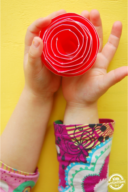Surface Tension is a difficult concept to understand but we’ve got a fun way to demonstrate it to your child to make it easier to understand. First we have an experiment with salt and then another experiment with LEGOs. At Kids Activities Blog, we know how to make science for kids fun and exciting.
Surface Tension
Surface tension is one of those concepts that is best explained visually. This simple experiment has a great “wow” factor and is a fun and quick way to demonstrate surface tension in action.
Experiment with Salt
All you need is a bowl of water, some pepper and small amount of dish washing liquid. Sprinkle the pepper over the surface of the water so that it is completely covered. Next, dip your finger into some dish washing liquid. Now dip your finger right into the center of the bowl of water and….wow! Watch as the pepper instantly disperses to the sides of the bowl. My son LOVES doing this and no matter how many times we do it, he still gasps “Wow!” and asks to do it again. It really is fun to watch it happen.
Science for Kids
My son is into Lego in a BIG way right now and so he asked whether we could try the same experiment using some Lego bricks. we began by floating some bricks on top of the water. We selected only the very flat, thin bricks to ensure they would float and disperse easily. The first thing we observed was that the Lego bricks slowly floated toward one another. This is a demonstration of surface tension. When you float objects in water, they will naturally seek out each other and the sides of the bowl. When explaining this to my son I said that the Lego bricks were looking to hold hands with each other and he found this pretty amusing to watch.
Surface Tension of Water
We filled the bowl with more Lego bricks so that almost the entire surface was covered in a layer of bricks. The surface tension experiment is not quite as effective with Lego as it is with pepper, but it works best if you have covered the entire surface as shown in the photo above.
Soap and Surface Tension
We dipped a craft stick into some dish washing liquid and then dipped it into the bowl of water. The Lego bricks quickly dispersed to the sides of the bowl. The impact of the Lego was not quite the “wow” factor of the pepper, as the visual was not so distinct, but it was still lots of fun to watch. Science and Lego for kids – how can you go wrong?
What is surface tension?
Surface tension describes the attraction or adhesion of molecules to one another on the surface of a liquid. In a bowl of water for instance, the water molecules underneath the surface have equal pressure on them from all directions – sideways, below and above. The water molecules on the surface of the water however, have unequal pressure on them since there are not water molecules above them. This causes the surface of the water to act like a stretchy skin or elastic band.
How does it work?
The surface of the water is like a stretchy elastic skin on top of the water. The surface tension is broken by the dish washing liquid and it snaps away quickly. As the water molecules try to straighten up again, they quickly move to the sides of the bowl, and the pepper moves with them.
More Kids Activities
We hope these ideas help explain surface tension to your child. The experiment with salt and pepper is especially fun to repeat over and over and over! For more super cool demonstrations and kids activities, please take a look at these ideas:

























Nice post. I used to be checking continuously this blog and I’m impressed! Extremely useful info specifically the closing phase 🙂 I maintain such info a lot. I used to be looking for this certain information for a very long time. Thanks and best of luck.